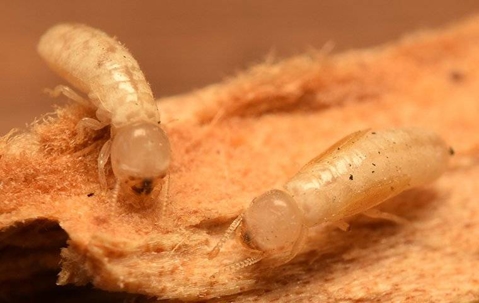Drywood termites can destroy all kinds of wood items throughout a home or business as they eat through anything from support beams to flooring and walls. Because of this, they are one of the most invasive and also most destructive pests around.
While many termite species need moisture to thrive, drywood termites do not. Subterranean termites gather moisture from the soil and seek out properties with excess humidity. They prefer water-damaged wood to eat. Drywood termites can sometimes be even more of a problem because they can damage even totally sound wooden objects and have much lower moisture needs than their relatives.
To help you protect your home from the destruction that drywood termites can cause, follow this guide to learn how to identify and prevent them.
What Do These Termites Look Like?
While spotting termites is usually not the first sign of an infestation, it can be helpful to know what they look like. Termites look different depending on their role in the colony. Termite swarmers, which leave the nest to reproduce, have wings and are a dark brown color. They look similar to flying ants.
The termite soldiers, on the other hand, have whitish bodies and dark brown heads. They don’t have wings, but they do have a large mandible coming out of their mouth. Termite workers look similar to the soldiers but lack distinctive jaws.
Other Signs Of Drywood Termites
Over time as the infestation grows, you might start to see termites around, especially the termite swarmers, but there are other signs you should know about. These indicators of termite activity can help you catch an infestation early on before the damage worsens.
Keep in mind that drywood termites specifically get inside homes through vents, rooflines, or other entrances or when people bring in items that already have termites in them. But, some signs of termite damage are the same regardless of the exact species.
Here is what you should look out for:
- Finding piles of discarded termite wings and skins around baseboards, doorways, and decks.
- Discovering tiny holes in the wood around your property
- Noticing that floorboards have started to squeak or buckle
- Doors and windows fit more tightly in their frames than they used to
If you notice signs of termites in or around your home it is important to act quickly.
Can You Remove Drywood Termites On Your Own?
Unfortunately, drywood termites are one of the most difficult pests to eradicate, so DIY methods almost always fail. The main reason for this is that you’re unlikely to notice the infestation until it’s already spread throughout your property, and these termites can live inside so many wooden items that are difficult to reach.
Luckily, there’s one simple way to eliminate termite infestations. The experts at Guaranteed Pest Service of Oklahoma can remove these destructive pests using safe, effective methods. Contact us today to request a free estimate.
How To Prevent Termites In The Future
If you don’t have termites or after the infestation has been removed, it’s a good idea to take preventive measures to keep termites away in the future. You can follow these three steps to prevent drywood termites:
- Remove entry points by sealing up cracks in the walls, foundation, and roofline using caulk and insulation foam.
- Look over lumber and any wood furniture to check for termite damage before bringing these products home.
- Store firewood at least 30 feet away from the exterior of any buildings.
Ongoing pest control along with annual termite inspections are also important steps to take in eliminating your risk of termites. Contact Guaranteed Pest Service of Oklahoma today to learn more about our service options.
Request Your Free Estimate
Complete the form below to schedule your no-obligation estimate.

